Question: Southwest Airlines Co. is a major airline
Southwest Airlines Co. is a major airline that operates in the United States. Refer to the following
information from Southwest Airlines’ 2015 3rd quarter 10-Q.
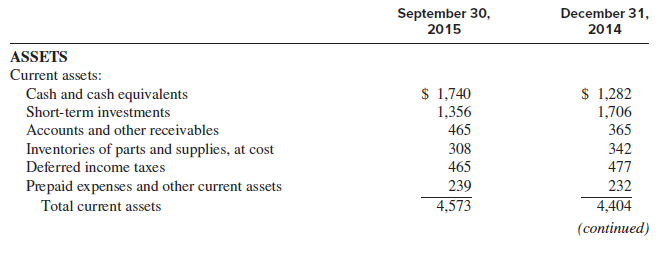
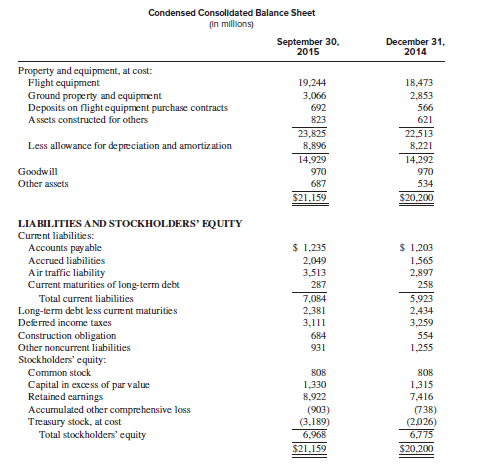
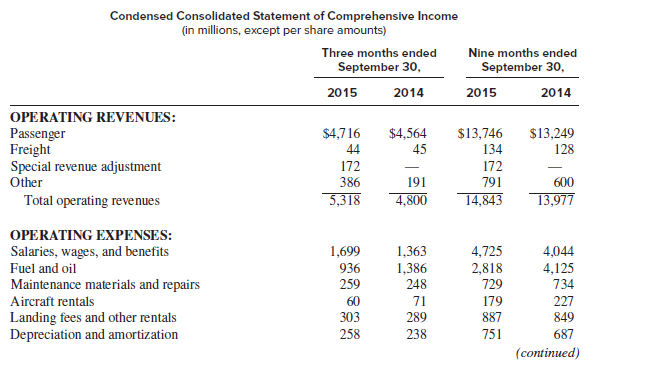
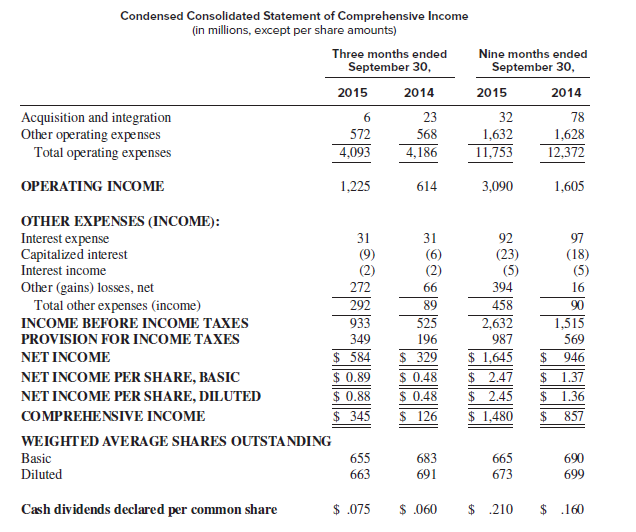
3. FINANCIAL DERIVATIVE INSTRUMENTS
Fuel contracts
Airline operators are inherently dependent upon energy to operate and, therefore, are impacted by changes in jet fuel prices. Furthermore, jet fuel and oil typically represent one of the largest operating expenses for airlines. The Company endeavors to acquire jet fuel at the lowest possible cost and to reduce volatility in operating expenses through its fuel hedging program. Although the Company may periodically enter into jet fuel derivatives for short-term time frames, because jet fuel is not widely traded on an organized futures exchange, there are limited opportunities to hedge directly in jet fuel for time horizons longer than approximately 24 months into the future. However, the Company has found that financial derivative instruments in other commodities, such as West Texas Intermediate (“WTIâ€) crude oil, Brent crude oil, and refined products, such as heating oil and unleaded gasoline, can be useful in decreasing its exposure to jet fuel price volatility. The Company does not purchase or hold any financial derivative instruments for trading or speculative purposes. The Company has used financial derivative instruments for both short-term and long-term time frames and primarily uses a mixture of purchased call options, collar structures (which include both a purchased call option and a sold put option), call spreads (which include a purchased call option and a sold call option), put spreads (which include a purchased put option and a sold put option), and fixed price swap agreements in its portfolio. Although the use of collar structures and swap agreements can reduce the overall cost of hedging, these instruments carry more risk than purchased call options in that the Company could end up in a liability position when the collar structure or swap agreement settles. With the use of purchased call options and call spreads, the Company cannot be in a liability position at settlement, but does not have coverage once market prices fall below the strike price of the purchased call option. The Company evaluates its hedge volumes strictly from an “economic†standpoint and thus does not consider whether the hedges have qualified or will qualify for hedge accounting. The Company defines its “economic†hedge as the net volume of fuel derivative contracts held, including the impact of positions that have been offset through sold positions, regardless of whether those contracts qualify for hedge accounting. The level at which the Company is economically hedged for a particular period is also dependent on current market prices for that period, as well as the types of derivative instruments held and the strike prices of those instruments. For example, the Company may enter into “out-of-the money†option contracts (including catastrophic protection), which may not generate intrinsic gains at settlement if market prices do not rise above the option strike price. Therefore, even though the Company may have an “economic†hedge in place for a particular period, that hedge may not produce any hedging gains at settlement and may even produce hedging losses depending on market prices, the types of instruments held, and the strike prices of those instruments. For the three months ended September 30, 2015, the Company had fuel derivative instruments that settled. Although a portion of these instruments finished “out of the money†and did not result in a payment to or from the counterparty at settlement, the instruments in place could have represented an “economic†hedge for up to 43 percent of its fuel consumption if prices had increased to significantly higher levels. During third quarter 2015, the Company reduced its hedge position related to future periods. This reduction in the Company’s hedge position primarily was accomplished through entering into offsetting derivatives that will also settle in the same periods as the economic hedge derivative. Prior to third quarter 2015, the Company had paid $39 million to counterparties to purchase offsetting derivatives that also settled during third quarter 2015. These transactions are reflected in the total economic fuel hedge settlement losses of $245 million recognized in Fuel and oil expense during third quarter 2015. The Company also paid $294 million to counterparties during third quarter 2015 to purchase offsetting derivatives that will settle in fourth quarter 2015 and first half 2016. Therefore, as of September 30, 2015, the Company no longer had an “economic†hedge in place for its remaining 2015 estimated fuel consumption. However, in periods prior to third quarter, the Company did have fourth quarter 2015 hedges in place that were subsequently offset.
/
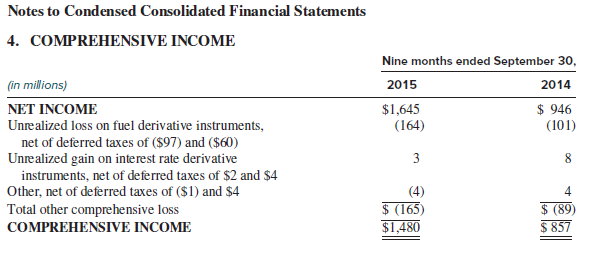
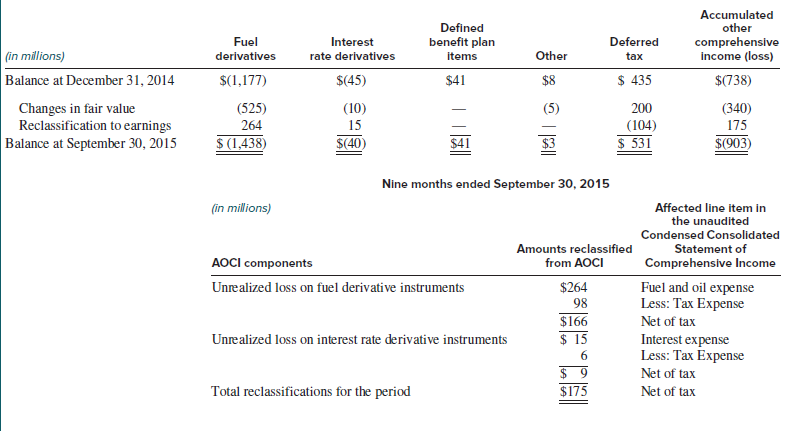
Required:
1. Refer to the statements of comprehensive income for the 9 months ended September 30, 2015, and September 2014, respectively. What is the main reason that 2015 net income is higher than 2014 net income?
2. Refer to Note 3. Why might an “economic†hedge not receive hedge accounting treatment?
3. Refer to Note 3. Why do you think Southwest chose to go without fuel hedges in the fourth quarter of 2015?
4. Refer to Note 4. Other comprehensive income includes after-tax losses on fuel contracts of $164 million. Does this indicate that these are the extent of the new losses occurring in 2015?
5. How would have Fuel and oil expense have changed in 2015 if Southwest had not used cash flow hedges?
6. Refer to Note 5. What does the note tell you about the timing of payments regarding derivative contracts?
Transcribed Image Text:
December 31, September 30, 2015 2014 ASSETS Current assets: Cash and cash equivalents Short-term investments $ 1,740 1,356 $ 1,282 1,706 Accounts and other receivables 465 365 Inventories of parts and supplies, at cost 308 342 Deferred income taxes 465 477 Prepaid expenses and other current assets 239 232 4,404 (сontinued) Total current assets 4,573 Condensed Consolidated Balance Sheet (In millions) September 30, 2015 December 31, 2014 Property and equipment, at cost: Flight equipment Ground property and equipment Deposits on flight equipment purchase contracts Assets constructed for others 19,244 18,473 3,066 2,853 692 566 823 621 23,825 8,896 22,513 8,221 Less allowance for de preciation and amortiz ation 14,929 14,292 Goodwill 970 970 Other assets 687 534 $21,159 $20,200 LIABILITIES AND STOCKHOLDERS' EQUITY Current liabilities: $ 1,203 1,565 $ 1,235 Accounts payable Accrued liabilities Air traffic liability Current maturities of long-term debt 2,049 3,513 2,897 287 258 Total current liabilities 7,084 Long-term debt less current maturities Deferred income taxes 2,381 3,111 5,923 2,434 3,259 Construction obligation 684 554 Other noncurrent liabilities 931 1,255 Stockholders' EQUITY: Сommon stock 808 808 1,315 1,330 Capital in excess of par value Retained earnings Accumulated other comprehensive loss Treasury stock, at cost Total stockholders' equity 8,922 7,416 (903) (3,189) (738) (2,026) 6,968 6,775 $21,159 $20,200 Condensed Consolidated Statement of Comprehensive Income (in millions, except per share amounts) Three months ended Nine months ended September 30, September 30, 2015 2014 2015 2014 OPERATING REVENUES: $13,249 Passenger Freight Special revenue adjustment Other $4,716 $4,564 45 $13,746 44 134 128 172 172 - - 386 191 791 600 Total operating revenues 5,318 4,800 14,843 13,977 OPERATING EXPENSES: Salaries, wages, and benefits 1,699 1,363 4,725 2,818 4,044 Fuel and oil 936 1,386 4,125 Maintenance materials and repairs 259 248 729 734 Aircraft rentals 60 71 179 227 Landing fees and other rentals Depreciation and amortization 303 289 887 849 258 238 751 687 (continued) Condensed Consolidated Statement of Comprehensive Income (in millions, except per share amounts) Three months ended September 30, Nine months ended September 30, 2015 2014 2015 2014 Acquisition and integration Other operating expenses Total operating expenses 6 23 32 78 572 568 1,632 11,753 1,628 12,372 4,093 4,186 OPERATING INCOME 1,225 614 3,090 1,605 OTHER EXPENSES (INCOME): Interest expense Capitalized interest 31 (9) (2) 31 92 97 (6) (2) (18) (5) (23) Interest income (5) 394 Other (gains) losses, net Total other expenses (income) 272 66 16 292 89 458 90 INCOME BEFORE INCOME TAXES 933 525 1,515 2,632 987 PROVISION FOR INCOME TAXES 349 196 569 $ 329 $ 0.48 $ 584 $ 0.89 $ 0.88 $ 345 $ 1,645 $ 2.47 $ 2.45 $ 1,480 NET INCOME $ 946 $ 1.37 NET INCOME PER SHARE, BASIC NET INCOME PER SHARE, DILUTED $ 0.48 2$ 1.36 COMPREHENSIVE INCOME $ 126 857 WEIGHTED AVERAGE SHARES OUTSTANDING 690 699 Basic 655 663 683 665 Diluted 691 673 Cash dividends declared per common share $.075 $.060 $ 210 .160 Notes to Condensed Consolidated Financial Statements 4. COMPREHENSIVE INCOME Nine months ended September 30, (in millions) 2015 2014 $ 946 $1,645 (164) NET INCOME Unrealized loss on fuel derivative instruments, (101) net of deferred taxes of ($97) and ($60) Unrealized gain on interest rate derivative instruments, net of deferred taxes of $2 and $4 Other, net of deferred taxes of ($1) and $4 Total other comprehensive loss 3 (4) $ (165) $1,480 4 $ (89) $ 857 COMPREHENSIVE INCOME Accumulated other Defined Fuel Interest benefit plan Deferred | (in millions) comprehensive income (loss) derivatives rate derivatives items Other tax Balance at December 31, 2014 $(1,177) $(45) $41 $8 $ 435 $(738) (340) Changes in fair value Reclassification to earnings Balance at September 30, 2015 (525) (10) 200 264 15 (104) 175 $ (1,438) $(40) $ 531 $(903) Nine months ended September 30, 2015 (in millions) Affected line item in the unaudited Condensed Consolidated Amounts reclassified Statement of AOCI components from AOCI Comprehensive Income Unrealized loss on fuel derivative instruments $264 Fuel and oil expense Less: Tax Expense 98 $166 Net of tax Unrealized loss on interest rate derivative instruments $ 15 Interest expense Less: Tax Expense 6. $ 9 Net of tax Total reclassifications for the period $175 Net of tax
> Sandra Company and Nova Inc. each signed lease agreements on January 1, 2017. Nova’s lease qualified for capital lease treatment, but Sandra’s lease did not. All other information for both companies is identical. Payme
> Mickelson reports on a calendar year basis. On January 1, 2017, Mickelson Corporation enters into a three-year lease with annual payments of $30,000. The first payment will be due on December 31, 2017. The present value of the payments at 8% is $77,313.
> On December 31, 2017, Lane, Inc., sold equipment to Nolte and simultaneously leased it back for 12 years. Pertinent information at this date is as follows: Sales price ……………………………… $480,000 Carrying amount………………………………$360,000 Estimated remaining economi
> On December 31, 2017, Roe Company leased a machine from Colt for a five-year period. Equal annual payments under the lease are $105,000 (including $5,000 annual executory costs for servicing) and are due on December 31 of each year. The first payment was
> At December 31, 2015, ExxonMobil had 4,156 million shares of outstanding common stock. The closing market price of each share of stock at December 31, 2015, was $77.95. Presented below are excerpts from the 2015 annual report of ExxonMobil Corporation. T
> On January 1, 2017, Babson, Inc., leased two automobiles for executive use. The lease requires Babson to make five annual payments of $13,000, beginning January 1, 2017. At the end of the lease term on December 31, 2021, Babson guarantees that the residu
> On October 1, 2017, Vaughn, Inc., leased a machine from Fell Leasing Company for five years. The lease requires five annual payments of $10,000 beginning September 30, 2018. Vaughn’s incremental borrowing rate is 11%, and it uses a calendar year for repo
> On December 31, 2017, Day Company leased a new machine from Parr with the following pertinent information: Lease term ……………………………………………………………………………... 5 years Annual rental payable on December 31 (beginning December 31, 2017) ……... $50,000 Useful life
> Monk Company, a dealer in machinery and equipment, leased equipment with a 10-year life to Leland Inc. on July 1, 2017. The lease is appropriately accounted for as a sale by Monk and as a purchase by Leland. The lease is for an eight-year period, expirin
> On January 1, 2017, 3Way Energy issued $200 million of 15-year, floating-rate debentures at par value. The debentures pay interest on June 30 and December 31 of each year. The floating interest rate is set equal to “LIBOR plus 6%” on January 1 of each ye
> Zero coupon bonds pay no interest—the only cash investors receive is the lump-sum principal payment at maturity. On January 1, 2017, The Ledge Inc. issued $250 million of zero coupon bonds at a market yield rate of 12%. The bonds mature in 20 years. Req
> Brower Corporation owns a manufacturing plant in the country of Oust. On December 31, 2017, the plant had a book value of $5,000,000 and an estimated fair value of $8,000,000. Oust’s government has clearly indicated that it will expropriate the plant dur
> Webb Company has outstanding a 7% annual, 10-year, $100,000 face value bond that it had issued several years ago. It originally sold the bond to yield 6% annual interest. Webb uses the effective interest rate method to amortize the bond premium. On June
> On February 1, 2015, Davis Corporation issued 12%, $1,000,000 par, 10-year bonds for $1,117,000. Davis reacquired all of these bonds at 102% of par, plus accrued interest, on May 1, 2018, and retired them. The unamortized bond premium on that date was $7
> On January 2, 2017, West Company issued 9% bonds in the amount of $500,000 that mature on December 31, 2026. The bonds were issued for $469,500 to yield 10%. Interest is payable annually on December 31. West uses the effective interest method of amortizi
> Novartis, which files under IFRS, reported the following information in its first quarter report for 2013: Impact of introducing revised accounting standard on Employee Benefits in 2013 The Group introduced the revised IFRS accounting standard IAS 19 (R)
> On January 1, 2017, when the market interest rate was 14%, Luba Corporation issued bonds in the face amount of $500,000 with interest at 12% payable semiannually. The bonds mature on December 31, 2026. Required: Calculate the bond discount at issuance.
> By July 1, 2018, the market yield on the Akers Company bonds described in E11–1 had risen to 10%. Required: What was the bonds’ market price on July 1, 2018?
> Lufthansa Group operates an international airline based in Germany. Lufthansa files its annual reports under International Financial Reporting Standards (IFRS). In its 2012 Annual Report to shareholders, Lufthansa presented the following information in a
> Under Armour, a maker of athletic sportswear, had a tax provision of about $134 million in 2014. Following is the 2014 note disclosure for Under Armour’s uncertain tax positions. Provision for Income Taxes (Excerpt) As of December 31, 2014 and 2013, the
> The following partial income statement and income tax note excerpts were taken from Sirius XM Inc.’s 2012 Form 10-K. During 2012, Sirius XM eliminated most of the valuation allowance it had built up, reducing it to $9.8 million at Dec
> Excerpts from Starbucks Corporation’s tax note from the company’s Form 10-K for the year ended September 27, 2015, follow. Required: 1. Provide a journal entry to record the aggregate income tax expense for the yea
> ABC Inc. is in the business of airframe maintenance, modification and retrofit services, avionics and aircraft interior installations, the overhaul and repair of aircraft engines, and other related services. The following are excerpted from its income st
> lululemon athletica and Under Armour are both in the athletic apparel business. But the two companies’ depreciation methods differ. The following explanations were excerpted from the two companies’ fiscal 2014 financia
> Edited excerpts from Alphabet Inc.’s (parent of Google) 2015 tax note follow: Required: 1. Prepare the book journal entry for income tax expense for 2015 (combine U.S., foreign, and state income taxes). Clearly indicate both the acco
> The following tables were excerpted from Pepsico’s 2015 Form 10-K. All amounts are in millions of dollars and the deferred tax asset and liability amounts are as of December 31 of the respective year. Required: 1. Provide journal en
> Refer to the 2014 General Electric Retiree Health and Life Benefits disclosure appearing in Exhibit 14.6. 1. Reconstruct the journal entries that GE would have made in 2014 to record the effects of its retiree health and life benefits plans. As was the c
> Walgreens Boots Alliance, Inc. is a global pharmacy-led health and well-being enterprise. It has 13,100 stores in 11 countries. Walgreens Boots Alliance was incorporated in 2014 and is the successor to Walgreen Co., which was originally incorporated in 1
> Refer to the Delta Air Lines financial statement information contained in C12-1. 1. Explain how the financial statements and disclosures would change if Delta were using IAS 17 instead of FASB ASC 840. Be as specific as possible. 2. Explain how the finan
> During 2017, Orr Company incurred the following costs: Research and development services performed by Key Corporation for Orr ……… $150,000 Design, construction, and testing of preproduction prototypes and models …………. 200,000 Testing in search for new
> In Figland Company’s first year of operations (2017), the company had pre-tax book income of $500,000 and taxable income of $800,000. Figland’s only temporary difference is for accrued product warranty costs, which are expected to be paid as follows: 20
> The following graph depicts three depreciation expense patterns over time. Pattern I, of course, is straight-line depreciation. Which depreciation expense pattern corresponds to the sum-of-the-years’ digits method and which correspo
> Quinn Company reported a net deferred tax asset of $10,500 in its December 31, 2016, balance sheet. For 2017, Quinn reported pre-tax financial statement income of $300,000. Temporary differences of $100,000 resulted in taxable income of $200,000 for 2017
> West Corporation leased a building and received the $36,000 annual rental payment on July 15, 2017. The beginning of the lease period was August 1, 2017. Rental income is taxable when received. West had no other permanent or temporary differences. West’s
> Moss Inc. follows GAAP for financial reporting purposes and appropriately uses the installment method of accounting for income tax purposes. It reported $250,000 of pre-tax income under GAAP, but it will report the corresponding taxable income in the fol
> For its third year of operations, 2017, Delilah Corp. is reporting pre-tax book income of $223,000. The following items are relevant to Delilah’s deferred tax computations: Required: 1. In 2017, Delilah had a $55,000 unrealized holding gain on its tradi
> Over the past two years, Madison Corporation has accumulated operating loss carryforwards of $66,000. This year, 2017, Madison’s pre-tax book income is $101,500. The company is subject to a 35% corporate tax rate. The following items ar
> Bryan Trucking Corporation began business on January 1, 2017, and consists of the parent entity, domiciled and operating in Country X, and a subsidiary operating in Country Y. Bryan is required, as a listed company in Country X, to prepare financial stat
> Delta Air Lines provides scheduled air transportation for passengers and cargo throughout the United States and globally a fleet of more than 900 aircraft. Information from its 2015 annual report follows. NOTE 7. LEASE OBLIGATIONS We lease aircraft, a
> On January 1, 2011, the Dolan Company purchased a new office building in Las Vegas, for $6,100,000, which it holds for rentals and capital appreciation. Dolan estimated the building would have a useful life of 25 years and a residual value of $1,100,000.
> Metge Corporation’s worksheet for calculating taxable income for 2017 follows: The enacted tax rate for 2017 is 35%, but it is scheduled to increase to 40% in 2018 and subsequent years. All temporary differences are originating differ
> Nelson Inc. purchased machinery at the beginning of 2017 for $90,000. Management used the straight-line method to depreciate the cost for financial reporting purposes and the sum-of the- years’ digits method to depreciate the cost for tax purposes. The l
> For financial statement reporting, Lexington Corporation recognizes royalty income according to GAAP. However, royalties are taxed when collected. At December 31, 2016, deferred royalty income of $400,000 was included in Lexington’s balance sheet. All of
> The following information pertains to Ramesh Company for the current year: Book income before income taxes ……………….………………. $106,000 Income tax expense ……………….……………….……………….45,500 Income taxes due for this year ……………….……………….28,000 Statutory income tax ra
> Boers Corporation and Bernstein, Inc., both project pre-tax income of $100 million in 2017. Both also expect there to be no change in their cumulative temporary differences during the year. However, the two companies are in very different deferred tax po
> In the current year, 2017, Reality Corporation reported $200,000 of pre-tax earnings on its income statement. The corporate tax rate is 35% in the current year and next year, and it is scheduled to remain at this level for the foreseeable future. Additio
> Flower Company started doing business on January 1, 2016. For the year ended December 31, 2017, it reported $450,000 pre-tax book income on its income statement. Flower is subject to a 35% corporate tax rate for this year and the foreseeable future. Addi
> In 2017, MB Inc. is subject to a 35% tax rate. For book purposes, it expenses $1,500 of expenditures. MB intends to deduct these expenditures on its 2017 tax return despite tax law precedent that makes it less than 50% probable that the deduction will be
> In 2017, Phillips Company reported $10,000 of pre-tax book income and also had $10,000 of taxable income. It incurred a $1,000 book expense that it deducted on its tax return. Assuming a 35% tax rate, this deduction results in a $350 tax benefit. The tax
> Mozart Inc.’s $98,000 taxable income for 2017 will be taxed at the 35% corporate tax rate. For tax purposes, its depreciation expense exceeded the depreciation used for financial reporting purposes by $27,000. Mozart has $45,000 of purchased goodwill on
> On July 1, 2017, Burgundy Studios leases camera equipment from Corningstone Corporation. The lease covers eight years and requires lease payments of $42,000, beginning on July 1, 2017. The unguaranteed residual value is $90,000. On July 1, 2017, the equi
> Kingston Corporation adopted ASU 2016-02 on January 1, 2017. On December 31, 2017, Thomas Henley, financial vice president of Kingston Corporation, signed a noncancelable three-year lease for a excavator. The lease calls for annual payments of $41,635 pe
> Using the data in P12–6, prepare the journal entries required by Coleman Inc. on January 1, 2017, assuming that (a) Task does not guarantee the residual value and (b) Task does guarantee it. Coleman paid $500,000 to acquire the office equipment several
> On January 1, 2017, Task Co. signs an agreement to lease office equipment from Coleman Inc. for three years with payments of $193,357 beginning December 31, 2017. The equipment’s fair value is $500,000 with an expected useful life of four years. At the e
> On January 1, 2017, Bare Trees Company signed a three-year noncancelable lease with Dreams Inc. The lease calls for three payments of $62,258.09 to be made at each year-end. The lease payments include $3,000 of executory costs related to service. The lea
> On January 1, 2017, Bill Inc. leases manufacturing equipment from Beatrix Corporation. The lease covers seven years and requires annual lease payments of $51,000, beginning on January 1, 2017. The unguaranteed residual value at the end of seven years is
> On January 1, 2017, Seven Wonders Inc. signed a five-year noncancelable lease with Moss Company. The lease calls for five payments of $277,409.44 to be made at the end of each year. The leased asset has a fair value of $1,200,000 on January 1, 2017. Seve
> Lessor Company has a machine with a cost and fair value of $100,000 that it leases for a 10-year period to Lessee Company. The machine has a 12-year expected economic life. Payments are received at the beginning of each year. The machine is expected to h
> In its 2012 Annual Report, Singapore Airlines, which primarily complies with IFRS, reported the following expected future minimum lease payments (in $ million). In its 2012 Annual Report filed under U.S. GAAP, United Continental Holdings, which owns Un
> The cereal division of Kellogg Company intends to test market next year an organic corn based cereal to be called NutriFlakesTR. The business plan calls for production to begin in late May 2015, with retail store delivery starting in early June. Annie Gl
> On January 1, 2017, Dwyer Company leases space for a donut shop. The lease is for five years with payments to be made at the beginning of each year. The lease calls for Dwyer to pay $10,000 on January 1, 2017, $11,000 on January 1, 2018, $12,500 on Janua
> This problem is designed to allow you to see how different lease durations and interest rates affect the relationship between the capitalized lease asset and lease liability. Of course, these same asset–liability relationships apply if you wish to constr
> On January 1, 2017, Merchant Co. sold a tractor to Swanson Inc. and simultaneously leased it back for five years. The tractor’s fair value is $250,000, but its carrying value on Merchant’s books prior to the transaction was $200,000. The tractor has a si
> As a loan officer for First Bank, you’re evaluating Newton Co.’s financial statements. Your evaluation reveals that Newton has no capital leases recorded on its financial statements. To effectively evaluate Newton&acir
> On January 1, 2017, Overseas Leasing Inc. (the lessor) purchased five used oil tankers from Seven Seas Shipping Company at a price of $99,817,750. Overseas immediately leased the oil tankers to Pacific Ocean Oil Company (the lessee) on the same date. The
> Assume that on January 1, 2017, Trans Global Airlines leases two used Boeing 737s from Aircraft Lessors Inc. The eight-year lease calls for payments of $10,000,000 at each year-end. On January 1, 2017, the Boeing 737s have a total fair value of $60,000,0
> Moore Company sells and leases its computers. Moore’s cost and sales price per machine are $1,200 and $3,000, respectively. At the end of three years, the expected residual value is $400, which is guaranteed by the lessee. Moore leases 20 of these machin
> Refer to the information in P12–10. Assume that at the commencement of the lease, collectibility of the payments is not probable and the lessor uses the straight-line depreciation method. Required: 1. Prepare the necessary journal entries for Railcar
> Railcar Leasing Inc. early adopts ASU 2016-02 on January 1, 2017. Also, on January 1, 2017, Railcar Leasing Inc. (the lessor) purchased 10 used boxcars from Railroad Equipment Consolidators at a price of $8,749,520. Railcar leased the boxcars to the Read
> Bunker Company negotiated a lease with Gilbreth Company that begins on January 1, 2017. The lease term is three years, and the asset’s economic life is four years. The annual lease payments are $7,500, payable at the end of the year. The cost and fair va
> Groupe Casino is a French multinational company that operates more than 9,000 multiformat retail stores—hypermarkets, supermarkets, discount stores, convenience stores, and restaurants—throughout the world. In January 20X5, Casino issued €600 million of
> Describes Chalk Hill’s use of an interest rate swap to hedge its cash flow exposure to interest rate risk from variable rate debt. The journal entries in the exhibit illustrate how special “hedge accounting” rules apply to the swap. Suppose instead that
> In 2009, Citigroup used the fair value option for some of its own debt. During the first quarter of 2009, the fair value of its debt declined by $2.7 billion. Its reported net income for the quarter was $1.6 billion. Required: 1. Suppose Citigroup had
> On January 1, 2017, Tango-In-The-Night, Inc., issued $75 million of bonds with an 8% coupon interest rate. The bonds mature in 10 years and pay interest semi-annually on June 30 and on December 31 of each year. The market rate of interest on January 1, 2
> On July 1, 2017, Stan Getz, Inc., bought call option contracts for 500 shares of Selmer Manufacturing common stock. The contracts cost $200, expire on September 15, and have an exercise price of $40 per share. The market price of Selmer’s stock that day
> On January 1, 2017, Mason Manufacturing borrows $500,000 and uses the money to purchase corporate bonds for investment purposes. Interest rates were quite volatile that year and so were the fair values of Mason’s bond investment (an ass
> On January 1, 2017, Newell Manufacturing purchased a new drill press that had a cash purchase price of $6,340. Newell decided instead to pay on an installment basis. The installment contract calls for four annual payments of $2,000 each beginning in one
> On January 1, 2017, Fleetwood Inc. issued bonds with a face amount of $25 million and a stated interest rate of 8%. The bonds mature in 10 years and pay interest semiannually on June 30 and December 31 of each year. The market rate of interest on January
> Silverado Inc. buys titanium from a supplier that requires a six-month firm commitment on all purchases. On January 1, 2017, Silverado signs a contract with the supplier to purchase 10,000 pounds of titanium at the current forward rate of $310 per pound
> On July 1, 2017, LekTech Corporation issued $20 million of 12%, 20-year bonds. Interest on the bonds is paid semiannually on December 31 and June 30 of each year, and the bonds were issued at a market interest rate of 8%. Required: 1. Compute the bonds
> The following information was taken from the financial statements of ALZA Corporation. On July 28, 2000, ALZA completed a private offering of the 3% Zero Coupon Convertible Subordinated Debentures, which were issued at a price of $551.26 per $1,000 princ
> The following information was taken from the 2012 financial statements of Dentsply International, a company that develops, manufactures, and markets medical equipment and supplies for the global dental market. The Company has a $500.0 million five-year
> On July 1, 2017, McVay Corporation issued $15 million of 10-year bonds with an 8% stated interest rate. The bonds pay interest semiannually on June 30 and December 31 of each year. The market rate of interest on July 1, 2017, for bonds of this type was 1
> On January 1, 2007, Chain Corporation issued $5 million of 7% coupon bonds at par. The bonds mature in 20 years and pay interest semiannually on June 30 and December 31 of each year. On December 31, 2017, the market interest rate for bonds of similar ris
> The following information appeared in the annual reports of Borden, Inc., Exxon Corporation, and Visa Inc. Accruals for environmental matters are recorded when it is probable that a liability has been incurred and the amount of the liability can be reaso
> The following information appeared in the 2002 annual report of Lyondell Petrochemical Company, a manufacturer of petrochemicals and refined petroleum products such as gasoline, heating oil, jet fuel, aromatics, and lubricants: The Company is party to va
> On January 1, 2017, Nicks Corporation issued $250 million of floating-rate debt. The debt carries a contractual interest rate of “LIBOR plus 5.5%,” which is reset annually on January 1 of each year. The LIBOR rates on January 1, 2017, 2018, and 2019, wer
> Clovis Company recently issued $500,000 (face value) bonds to finance a new construction project. The company’s chief accountant prepared the following bond amortization schedule: Required: 1. Compute the discount or premium on the sa
> In May 2002, Checkpoint lost a court case and was required to pay damages of $26 million. Recognizing the $26 million as a liability could violate debt-to-asset and net worth debt covenants. Violation of the covenants could allow a creditor to renegotiat
> The following excerpts are from the financial statement note on Derivative Instruments and Hedging Activities in Molson Coors Brewing Company’s 2009 annual report: Simultaneous with the September 22, 2005, U.S. private debt placement, we entered into a c
> Information taken from a Sears, Roebuck and Company annual report follows. Required: 1. How much interest expense did the company record during Year 2 on the 7% debentures? How much of the original issue discount was amortized during Year 2? 2. How muc
> The following information appeared in the 2017 annual report of Rumours, Inc.: Rumours, Inc. issued $10 million, 10% coupon bonds on January 1, 2014, due on December 31, 2018. The prevailing market interest rate on January 1, 2014, was 12%, and the bonds
> Tuesday Morning Corporation operates a chain of discount retail stores. The company purchases closeout merchandise at prices generally ranging from 10% to 50% of the normal wholesale price and sells the merchandise at prices that are 50% to 80% lower tha
> The CFO at Brosnan, Inc., a book publisher, is concerned about the rising prices of paper and ink. She is considering the use of derivatives to lock in today’s prices. Required: 1. One strategy used by Brosnan, Inc., is to buy pulp-paper futures on comm
> Greg Miller wants to buy a new automobile. The dealer has the exact car Miller wants and has given him two payment options: pay (1) the full cash price of $19,326 today or (2) only $2,000 down today and then make four more annual payments of $5,000 begin
> Recall the Rombaurer Metals example in the chapter: On October 1, 2017, Rombaurer has 10 million pounds of copper inventory on hand at an average cost of $0.65 a pound. The spot price for copper is $0.90 a pound. Instead of selling copper now, Rombaurer
> On January 1, 2017, Four Brothers Manufacturing borrowed $10 million from Guiffrie Bank by signing a three-year, 8.0% fixed-rate note. The note calls for interest to be paid annually on December 31. The company then entered into an interest rate swap agr
> Basie Business Forms borrowed $5 million on July 1, 2017, from First Kansas City Bank. The loan required annual interest payments at the LIBOR rate, reset annually each June 30. The loan principal is due in five years. The LIBOR rate for the first year i
> Newton Grains plans to sell 100,000 bushels of corn from its current inventory in March 2018. The company paid $1 million for the corn during the fall 2017 harvest season. On October 1, 2017, Newton writes a forward contract to sell 100,000 bushels of co
> IceCap Hotels operates a series of northern European hotels and reports under IFRS. On June 30, 2016, IceCap purchased a hotel for €2,100,000. IceCap reports hotel values on the balance sheet under property, plant, and equipment. The estimated useful lif

